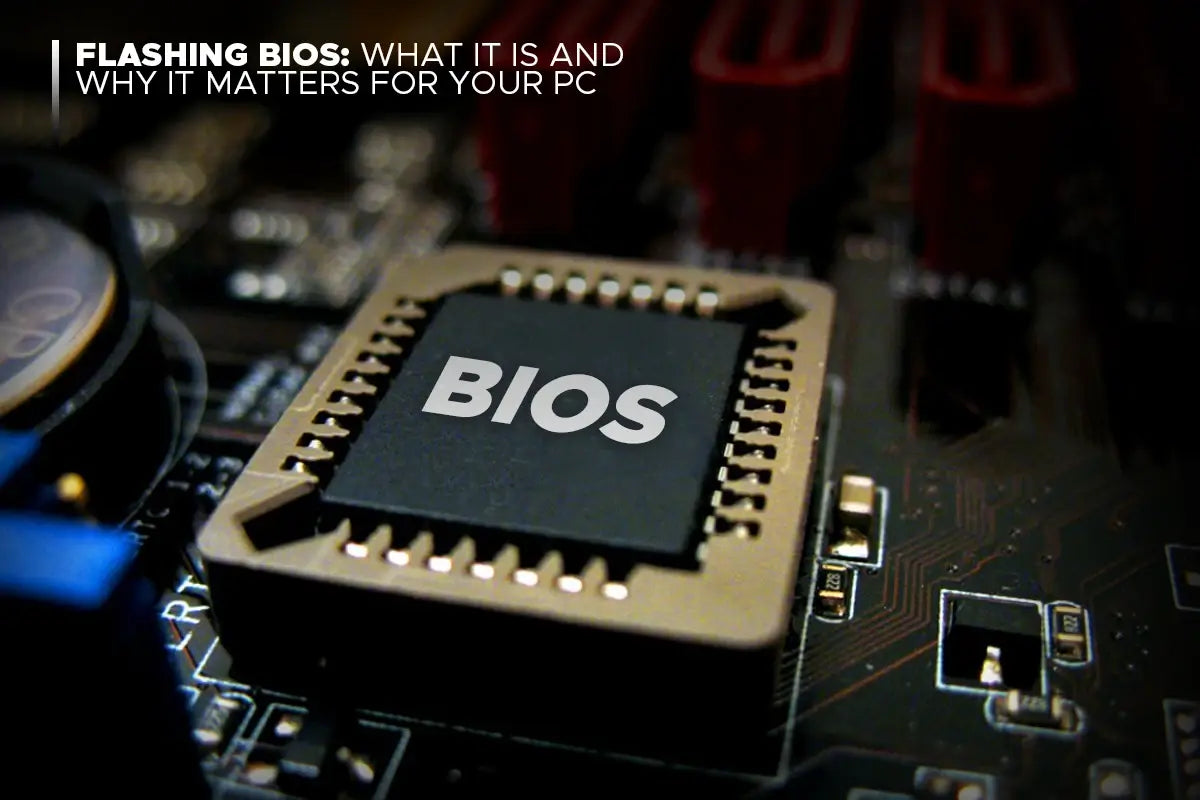If you're a tech enthusiast, gamer, or rely on high-performance computing, you may have come across the term "flashing BIOS."
But what exactly does it mean—and why is it so important?
The Basic Input/Output System (BIOS) is the firmware that helps your computer boot up and communicate with its hardware components. Flashing the BIOS—also known as updating it—is the process of installing a newer version of this firmware. It can be a critical step in improving system compatibility, enhancing performance, and fixing hardware-related issues.
In this blog, we’ll break down what flashing BIOS is, its benefits and potential risks, and when you should consider doing it. Whether you're upgrading your CPU, addressing compatibility problems, or applying security patches, knowing about flashing BIOS is essential to maintaining a stable, efficient PC.
BIOS: What is it and why should we care?
Basic Input/Output System (BIOS) is the fundamental software on your motherboard. It's the brain behind starting the hardware of your computer.
When the power button is pushed, the BIOS steps in and conducts a series of tests known as POST (Power-On Self Test). This confirms that all the hardware parts are operating as intended before giving control to your operating system.
Various Functions of BIOS
-
Hardware Initialization: Finds and starts hardware components like a central processing unit, random access memory, graphics card, and storage drives.
-
Operating System: Boot the operating system from your storage device into memory.
-
Hardware Settings: Allows you to choose hardware settings, overclocking preferences, and security choices.
The Value of BIOS for High-Performance Users and Gamers
For gaming enthusiasts and PC users, BIOS settings can define hardware compatibility, overclocking potential, and system stability.
With a well-updated BIOS, your computer will be able to handle fresh components like new CPUs or RAM sticks, hence enhancing gaming experiences as well as general performance.
What Does Flashing BIOS Mean?
Flashing BIOS is the operation of upgrading or rewriting the BIOS firmware contained on your motherboard. It is the process of replacing the current BIOS code with a new one offered by your motherboard maker.
How to Flash BIOS?
- BIOS Flashback: Motherboard capability that enables BIOS updates with CPU and RAM not installed.
- USB BIOS Update: Download the update to a USB stick and flash through the BIOS menu.
- Software Tools: Utilizing proprietary software within the OS, such as ASUS EZ Flash or MSI Live Update.
Benefits of Flashing BIOS
Enhance Hardware Compatibility
Enhancing hardware compatibility is one of the primary benefits of flashing BIOS. For instance, your motherboard might need a BIOS update to properly recognize a newer CPU if you are upgrading.
This ensures that your PC has support for the latest processor, memory modules, and other peripherals.
Improve System Stability and Bug Fixes
Manufacturers typically release BIOS updates to fix bugs and enhance system stability.
These fixes can solve issues such as random crashes, booting problems, or hardware detection issues, making the user experience more seamless.
Security Patches
Similar to software, BIOS firmware can be vulnerable. Manufacturers issue periodic updates to close security loopholes, protecting your system from potential attacks.
Performance Enhancements
In certain situations, BIOS flashing can result in performance improvements, particularly via enhanced memory support or streamlined system settings. Gamers and performance seekers might experience smoother gameplay or quicker data processing.
Risks and Considerations
Even with its advantages, BIOS flashing is a delicate process with risks involved. A botched or interrupted process can brick your motherboard, making it inoperable.
Key Precautions
-
Use the Right BIOS File: Always obtain the firmware that is applicable to your motherboard model.
-
Be Careful and Follow Instructions: Manufacturers include precise instructions—don't deviate from them or you'll cause problems.
-
Backup Your BIOS Settings: Save your existing BIOS settings prior to updating.
-
Provide Power Stability: Utilize an uninterruptible power supply (UPS) to avoid loss of power during flashing.
When Should You Think of Flashing BIOS?
-
Upgrading to a New CPU or RAM: When your hardware is not being detected or is not functioning at its best.
-
Hardware Incompatibility or System Instability: When having crashes, freezes, or boot failures.
-
Manufacturer Recommendations: When there is a new BIOS version available just for your motherboard model.
Note: If your system is running smoothly and you’re not experiencing any hardware compatibility issues, flashing the BIOS is not necessary. In fact, unnecessary updates can introduce risks—so it’s best to update only when there's a clear benefit.
Wrap Up
Flashing BIOS is an incredibly powerful tool that can greatly improve the hardware compatibility, stability, and security of your PC. While it has numerous advantages, such as supporting new CPUs and fixing bugs, it also poses risks that must be well-controlled.
To stay safe, always follow manufacturer instructions, use the correct firmware version, and back up your settings before proceeding.
For more helpful guides on PC optimization, hardware upgrades, and gaming performance, be sure to visit the Technoid Inc. Blog.
FAQs
1. Is flashing the BIOS needed for regular computer use?
Not typically. BIOS updates are normally required only when replacing hardware, repairing bugs, or enhancing compatibility. If your system is working fine, you don't have to flash the BIOS.
2. Can I go back to an older version of the BIOS if something goes wrong?
BIOS rollback or recovery capabilities may be available on some motherboards. Always refer to your motherboard manual for methods to restore or recover a BIOS version.
3. How long will it take to flash the BIOS?
A couple of minutes in most cases. But it's crucial not to leave the process in order not to cause harm to your motherboard.
4. What do I do if my computer won't boot after flashing BIOS?
Attempt to reset BIOS settings by jumper or removing the CMOS battery. If nothing works, appeal to professional repair services.

 United States
United States

